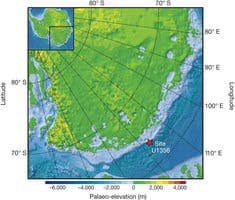Scientists who studied sediment cores drilled from the ocean floor off the Antarctic coast, have found on subsequent analysis fossil pollens that came from a tropical forest. Most likely, the continent was covered by rainforest some 52 million years ago. The researchers involved warn however that by the end of the century, ice from the Antarctic might retreat at the current rate of global warming, leaving the continent once again ice-free.
Kevin Welsh, an Australian scientist who traveled on the 2010 expedition, said that the international team of researchers he was a part of had discovered temperature-sensitive molecules in the cores showing that Antarctica was as warm as 68°F (20 Celsius) some 52 million years ago.
“There were forests existing on the land, there wouldn’t have been any ice, it would have been very warm,” Welsh told AFP of the study, published in the journal Nature.
“It’s quite surprising, because obviously our image of Antarctica is that it’s very cold and full of ice.”
The warmest global climates of the past 65 million years occurred during the early Eocene epoch (about 55 to 48 million years ago). Back then CO2 estimates of anywhere between 990 to “a couple of thousand” parts per million were presented in the atmosphere, compared to today’s CO2 levels estimated at 395ppm. The high level of CO2 is considered the major driver for atmospheric warming and Welsh said the most extreme predictions by the Intergovernmental Panel on Climate Change would see ice again receding on Antarctica “by the end of the century.”
“It’s difficult to say, because that’s really controlled by people’s and governments’ actions,” said Welsh, a paleoclimatologist from the University of Queensland. “It really depends on how emissions go in the future.”
During this mentioned period, the scientists believe the climate in lowland settings along the Wilkes Land coast (at a palaeolatitude of about 70° south) supported the growth of highly diverse, near-tropical forests characterized by mesothermal to megathermal floral elements including palms and Bombacoideae.
Currently, The ice on east Antarctica is 1.9-25 miles thick, and is thought to have formed about 34 million years ago.










